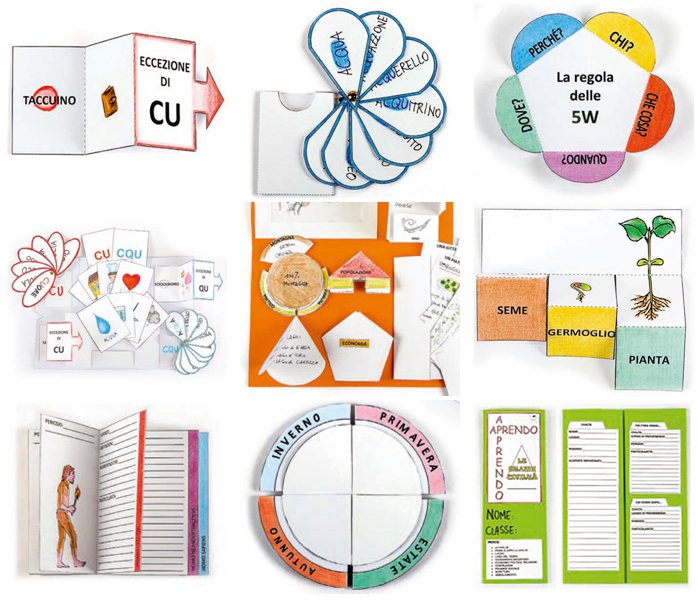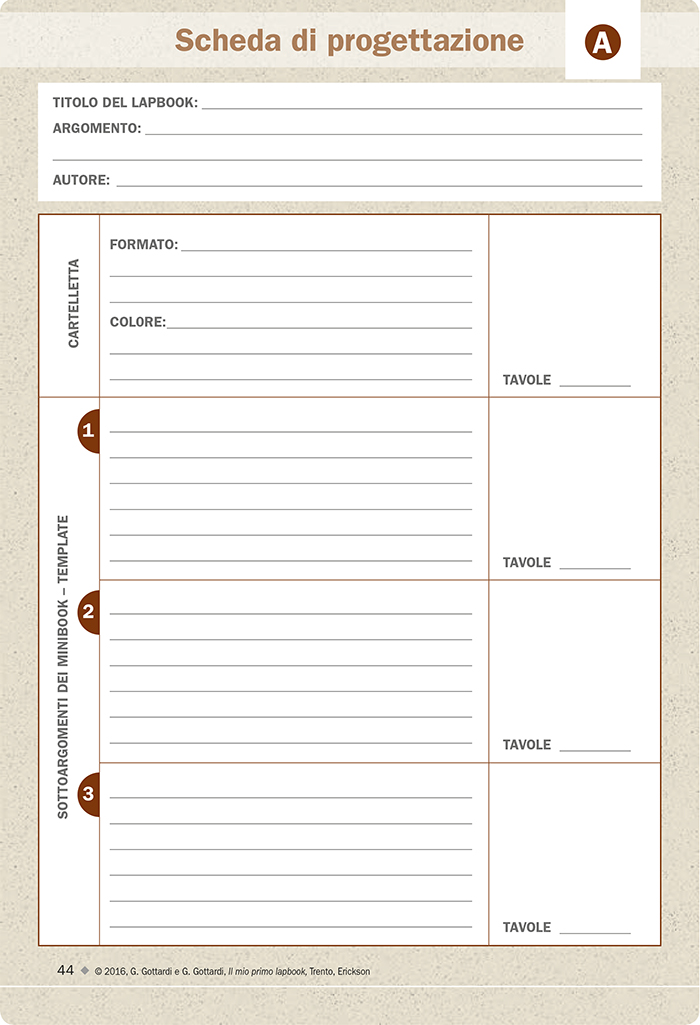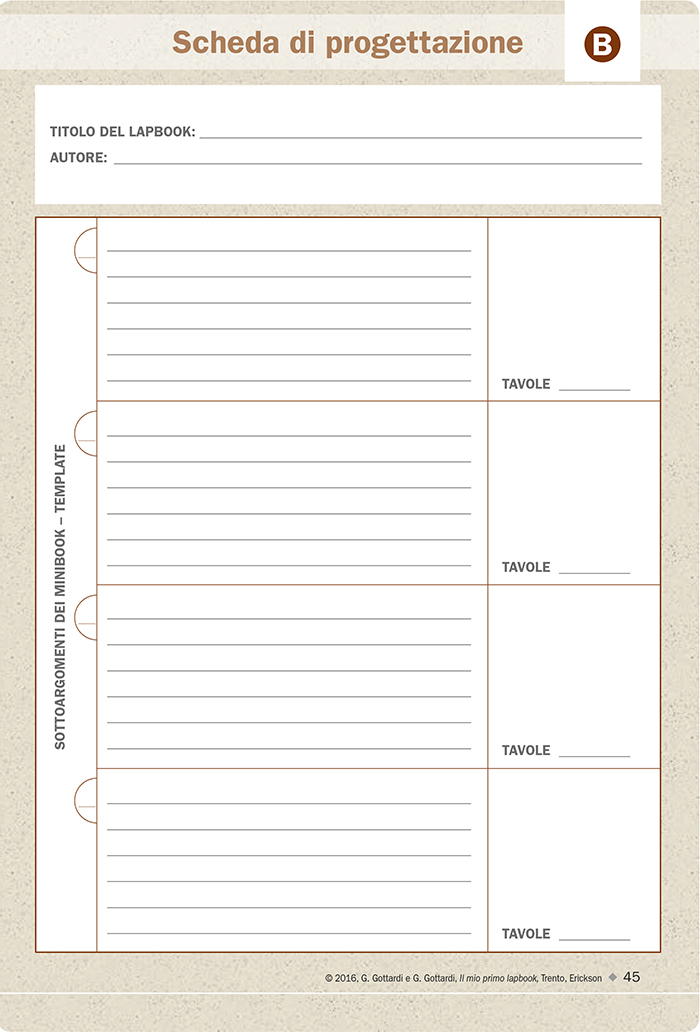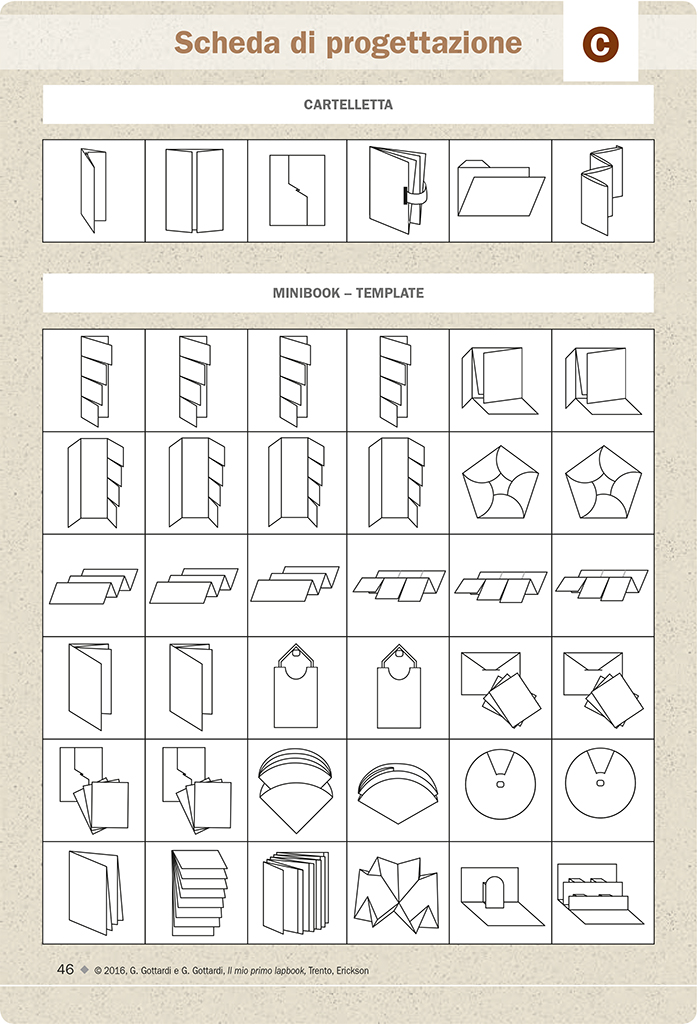 EN
EN
 PT
PT
Primary school - Fourth grade
Product: Book
Trim size in cm: 21x29,7cm
Pages: 96
ISBN: 9788859024149
Publication date: 01/01/2021
Suitable for: Primary 2nd level (ages 8-10)
REQUEST A SAMPLE OR MORE INFORMATION
The lapbook is a dynamic and creative collection of materials which falls under the scope of «learning by doing», where pupils remain at the centre of their own learning. It involves making little card folders of different shapes and sizes, which can be used to hold all items (drawings, photographs, short descriptions etc.) relating to a particular topic.
This book, the practical accompaniment to the suggestions contained in My first lapbook, is devoted specifically to learning several classic topics from the English curriculum for primary year four.
It contains all the instructions and materials needed for children to independently create 3 different kinds of lapbooks on the main topics of the English curriculum.
This book contains all the instructions and materials needed to create 3 different kinds of lapbooks.

What is a lapbook
A lapbook is a dynamic, creative collection of content. It is made out of folders, which can be of various sizes, according to intended use and necessity. It contains minibooks or templates which hold essential and specific information regarding a chosen topic.
The ultimate aim is to create a three-dimensional, interactive map of what you have studied and learnt, through a practical and personalised project.

Lapbooks in Kindergarten
Thanks to its hands-on and interactive component, the lapbook is also suitable for use in kindergarten to enhance basic skills and practice the prerequisites necessary for the transition to primary school. Starting from a chosen fairy tale, this book presents three Learning Units supported by the construction of a lapbook: • Goldilocks and the three bears (daily actions and feelings); • The little red hen (plants, the cycle of producing grain and experimenting with making bread); • The gigantic turnip (animals, fruit, vegetables, nutrition).
My first lapbook
This book doesn't offer ready-made lapbooks but is a collection of all the tools needed for thinking up, designing and creating original and personal lapbooks. When we work with pupils in class, lapbook design is a fundamental step: pupils must reflect on what is important and what they need to record in the limited space of each folder and thus learn to skim off information and to select key notions.
Watch the presentation videoTeaching competences with lapbooks
“Teaching Competences with Lapbooks” proposes an original interdisciplinary didactic program aimed at primary school children making use of lapbooks as a tool, or rather three-dimensional concept maps to build, that summarize a topic in a creative and dynamic way.
Learning with lapbooks – Mathematics and Science
Third grade
This book, the practical accompaniment to the suggestions contained in My first lapbook, is devoted specifically to learning several classic topics from the maths and science curriculum for primary year three.
It contains all the instructions and materials needed for children to independently create 3 different kinds of lapbooks on The four operations, The units of measurement and From nucleus to exosphere.
Fourth grade
This book contains all the instructions and materials needed for children to independently create 3 different kinds of lapbooks on the main topics of the Maths and Science curriculum for primary year four.
Here are the topics of the lapbook: fractions, Euros, living beings.
Fifth grade
This book contains all the instructions and materials needed for children to independently create 3 different kinds of lapbooks on the main topics of the Maths and Science curriculum for primary year five.
Here are the topics of the lapbook: • Mathematics rules, Geometry, Energy sources.
Learning with lapbooks – Italian, History and Geography
Third grade
This book, the practical accompaniment to the suggestions contained in My first lapbook, is devoted specifically to learning several classic topics from the Italian language, history and geography for primary year three.
It contains all the instructions and materials needed for children to independently create 4 different kinds of lapbooks on Fables, Minimal phrases, From the Big Bang to Man and Climate and environments.
Fourth grade
This book contains all the instructions and materials needed for children to independently create 4 different kinds of lapbooks on the main topics of the Italian, History and Geography curriculum for primary year four.
Here are the topics of the lapbook: literary genres; types of text; the Ancient Egyptians; orientation and geographical maps.
Fifth grade
This book contains all the instructions and materials needed for children to independently create 5 different kinds of lapbooks on the main topics of the Italian, History and Geography curriculum for primary year five.
Here are the topics of the lapbook: Grammatical analysis, Logical analysis, Greek gods and heroes, The Romans, Italy.
Learning with lapbooks – English
Third grade
Dedicated to learning some classic topics from the English programme from the third grade of primary school, the volume presents all the information and materials needed to allow children to independently create 4 lapbooks on the main topics of the subject curriculum.
Here are the topics of the lapbook: Introducing myself; My house and my town; A school day; In English class I learn about...
Fourth grade
This volume offers indications and materials needed to create 3 lapbooks containing materials in English for fourth grade, to be used in class or independently, on the main topics of the subject curriculum.
Here are the topics of the lapbook: Telling the time; The weather; Festivities; Enjoy your meal!
Fifth grade
The volume provides instructions and materials needed to create 3 lapbooks and 5 minibooks containing materials in the English language for primary year five on the main topics of the subject curriculum. It can be used in class or independently.
Here are the topics of the lapbook: English, a global language; how to describe…; verbs; vocabulary.
Lapbooks are dynamic, engaging tools, which can be considered three-dimensional conceptual maps to be made as you tackle topics during lessons or as tools for summarising a topic once it has been completed.
Lapbooks become notebooks (for storing notes), text books (for in-depth analysis and information) and assessment tools, with which a wide range of skills can be assessed: research, planning, summarising, graphics etc. It is important that teachers teach pupils how to create lapbooks instead of simply providing them with pre-designed cut and stick models: giving pupils a ready-made tool reduces its value. The programme introducing the use of the lapbook must be extensive and contain, after an initial approach, a phase in which pupils learn to analyse what they know and what they need to study more in depth, to plan, to choose templates, to summarise contents independently and in their own words and to choose pictures, colours and fonts.Lapbook design worksheets
In order to create a lapbook we have provided a design worksheet, which helps the person involved in this phase (the teacher, student or parent) to follow the steps in the right order.
The lapbook design worksheet allows you to plan activities without skipping any steps, helping you to focus your attention on the essential parts of the project.
Let's look at how the lapbook design worksheet is set out and how to use it.

Worksheet A
Has a space at the top where you can write the lapbook's title, topic and author and a table at the bottom where you can note the type of folders chosen and all the information needed for the first three minibooks. You can stick pictures of the type of template you plan to use as a reminder in the column on the right (cutting out the picture from worksheet C) and note down the reference of the page containing the template you are going to copy or photocopy.

Worksheet B
Has a space a the top where you can write the title of the lapbook and author's name and four spaces where you can make a note of the topics and templates of the other minibooks you are going to make. Should you need more templates, simply print more copies of this worksheet.

Worksheet C
Contains multiple copies of the template icons used in the book. You'll need to photocopy this page so you can then cut out the icons and stick them in the third column of worksheets A and B, in order to have a illustrated reminder of what you are going to make.
Why make lapbooks at school?
Making lapbooks in class has several advantages, which can be grouped into three main areas: